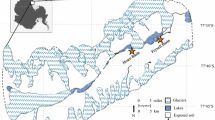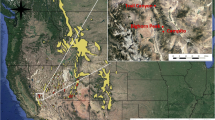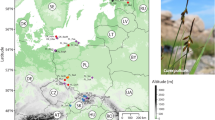Abstract
The effect of soil moisture on population dynamics of Paronychiurus kimi (Collembola) was examined by combining an empirical soil moisture model with a temperature-sensitive, stage-structured population model. Field observations of soil temperature were used to drive the population model, and simulations were compared to field observations of juvenile and adult densities. Simulations without soil moisture effects produced stable, interyear population dynamics and a significant correlation between simulations and observations (n=12, r 2=0.40, P<0.05) but overestimated densities during much of the year. Adding responses to soil moisture improved the fit between simulations and observations (n=13, r 2=0.40), suggesting that soil moisture is a major limiting factor on field populations of P. kimi. Moreover, an observed temporary decline in field populations during spring could be explained partly by the effects of an herbicide, paraquat (N,N′-dimethyl-gamma,gamma′-bipyridylium dichloride) (r 2=0.45), suggesting that paraquat imposes additional limits on collembolan populations.






Similar content being viewed by others
References
Al-Assiuty AIM, Khalil MA (1996) Effects of the herbicide atrazine on Entomobrya musatica (Collembola) in field and laboratory experiments. Appl Soil Ecol 4:139–146
Bauer R, Christian E (1993) Adaptations of three springtail species to granite boulder habitats (Collembola). Pedobiologia 37:280–290
Cassagne N, Gers C, Gauquelin T (2003) Relationships between Collembola, soil chemistry and humus types in forest stands (France). Biol Fertil Soils 37:355–361
Choi WI (2001) Population ecology of Paronychiurus kimi (Onychiuridae: Collembola) and the effects of three herbicides, paraquat, hexazinone and butachlor on the life history. Ph.D. thesis, Korea University, Seoul
Choi WI, Ryoo MI (2003) Matrix model for predicting seasonal fluctuations in field populations of Paronychiurus kimi (Collembola: Onychiruidae). Ecol Model 162:259–265
Choi WI, Ryoo MI, Kim J (2002) Biology of Paronychiurus kimi (Collembola: Onychiuridae) under the influences of temperature, humidity and nutrition. Pedobiologia 46:548–557
Diekkrüger B, Röske H (1995) Modelling the population dynamics of Isotoma notabilis (Collembola) on sites of different agricultural usage. Pedobiologia 39:58–73
Ferguson SH, Joly DO (2002) Dynamics of springtail and mite populations: the role of density dependence, predation, and weather. Ecol Entomol 27:565–573
Heupel K (2002) Avoidance response of different collembolan species to Betanal. Eur J Soil Biol 38:273–276
Højer R, Bayley M, Damgaard CF, Holmstrup M (2001) Stress synergy between drought and a common environmental contaminants: studies with the collembolan Folsomia candida. Glob Chang Biol 7:485–494
Hunt HW, Coleman DC, Ingham ER, Ingham RE, Elliot ET, Moore JC, Rose SL, Reid CPP, Morley CR (1987) The detrital food web in a shortgrass prairie. Biol Fertil Soils 3:57–68
Hunter MD, Adl S, Pringle CM, Coleman DC (2003) Relative effects of macroinvertebrates and habitat on the chemistry of litter during decomposition. Pedobiologia 47:101–115
Kang SY, Choi WI, Ryoo MI (2001) Demography of Paronychiurus kimi (Lee) population (Collembola: Onychiuridae) under the influence of glufosinate–ammonium on plaster charcoal substrate and artificial soil. Appl Soil Ecol 18:39–45
Ke X, Yang YM, Yin WY, Xue LZ (2004) Effects of low pH environment on the collembolan Onychiurus yaodai. Pedobiologia 48:545–550
Lactin DJ, Holliday NJ, Johnson DL, Craigen R (1995) Improved rate model of temperature-dependent development by arthropods. Environ Entomol 24:68–75
Longstaff BC (1977) The dynamics of Collembola populations: a matrix model of single species population growth. Can J Zool 55:314–324
Moorhead DL, Freckman DW, Reynolds JF, Whitford WG (1987) A simulation-model of soil nematode population dynamics: effects of moisture and temperature. Pedobiologia 30:361–372
Moorhead DL, Wall DH, Virginia RA, Parsons AN (2002) Distribution and life-cycle of Scottnema lindsayae (Nematoda) in Antarctic soils: a modeling analysis of temperature response. Polar Biol 25:118–125
Okoh IA, Badejo MA, Nathaniel IT, Tian G (1999) Studies on the bacteria, fungi and springtails (Collembola) of an agroforestry arboretum in Nigeria. Pedobiologia 43:18–27
Reth S, Reichstein M, Falge E (2005) The effects of soil water content, soil temperature, soil pH-value and the root mass on soil CO2 efflux—a modified model. Plant Soil 268:21–33
Seastedt TR (1984) The role of microarthropods in decomposition and mineralization processes. Annu Rev Entomol 29:25–46
Sjursen H, Holmstrup M (2004) Cold and drought stress in combination with pyrene exposure: studies with Protaphorura armata (Collembola: Onychiuridae). Ecotoxicol Environ Saf 57:145–152
Testerink GJ (1982) Metabolic adaptations to seasonal changes in humidity and temperature in litter-inhabiting springtails. Oikos 40:234–340
van Gestel CAM, van Diepen AMF (1997) The influence of soil moisture content on the bioavailability and toxicity of Cadmium for Folsomia candida Willem (Collembola: Isotomidae). Ecotoxicol Environ Saf 36:123–132
Weicht TR, Moorhead DL (2004) The impact of anhydrobiosis on the persistence of Scottnema lindsayae (Nematoda): a modeling analysis of population stability thresholds. Polar Biol 27:507–512
Acknowledgement
This work was supported by an award from the Department of Energy (DEAI0202ER63381).
Author information
Authors and Affiliations
Corresponding author
Rights and permissions
About this article
Cite this article
Choi, W.I., Moorhead, D.L., Neher, D.A. et al. A modeling study of soil temperature and moisture effects on population dynamics of Paronychiurus kimi (Collembola: Onychiuridae). Biol Fertil Soils 43, 69–75 (2006). https://doi.org/10.1007/s00374-005-0062-5
Received:
Revised:
Accepted:
Published:
Issue Date:
DOI: https://doi.org/10.1007/s00374-005-0062-5




